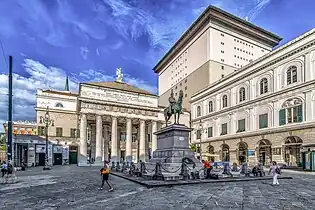Carlo Francesco Barabino | |
|---|---|
 | |
| Born | February 11, 1768 |
| Died | September 3, 1835 |
| Nationality | Italian |
| Known for | Architecture |
| Movement | Neoclassicism |
Carlo Barabino (February 11, 1768 – September 3, 1835) was a prominent Italian architect of the Neoclassic period, active mainly in his native Genoa. He was a pupil of Giuseppe Barbieri. Barabino became the City Architect of Genoa in 1818. He designed the original Teatro Carlo Felice Opera House in Genoa; facade rebuilt after destruction in World War II. He also built the Palazzo Dell'Accademia in Genoa, and the facades of Santa Maria Assunta, Genoa (Carignano), San Siro, and the Basilica della Santissima Annunziata del Vastato. He established the plan for the Monumental Cemetery of Staglieno in Genoa.[1]

Teatro Carlo Felice
References
- Corrado, Ricci (1911). Art in Northern Italy. New York: Charles Scribner's Sons. p. 258.
This article is issued from Wikipedia. The text is licensed under Creative Commons - Attribution - Sharealike. Additional terms may apply for the media files.